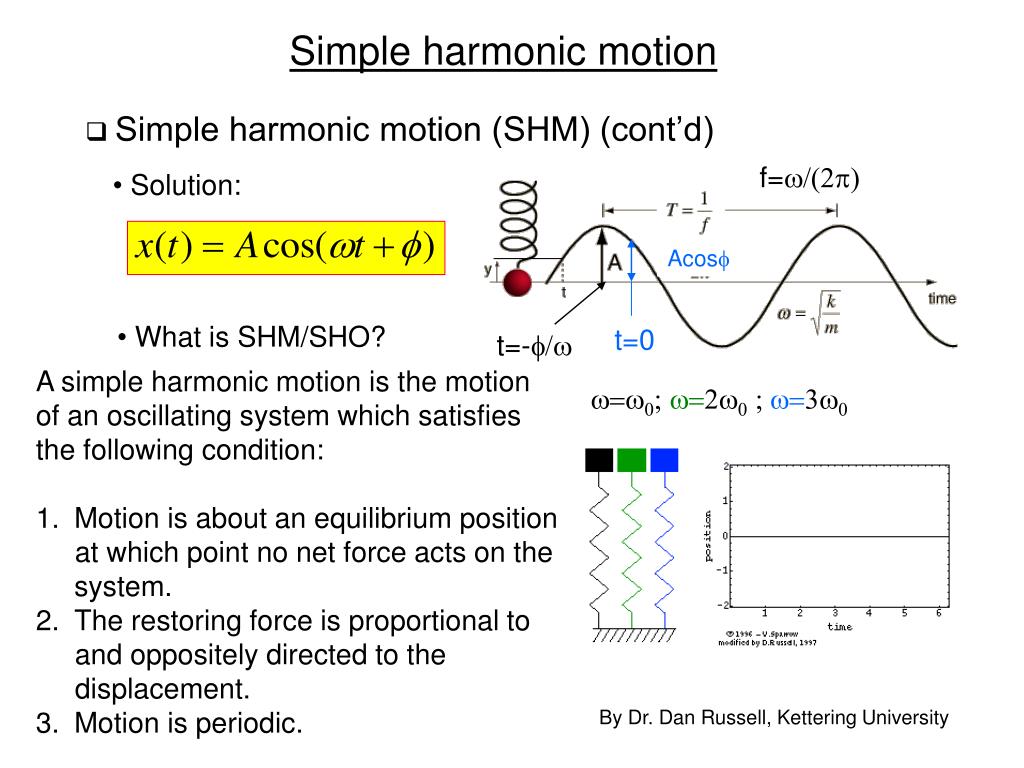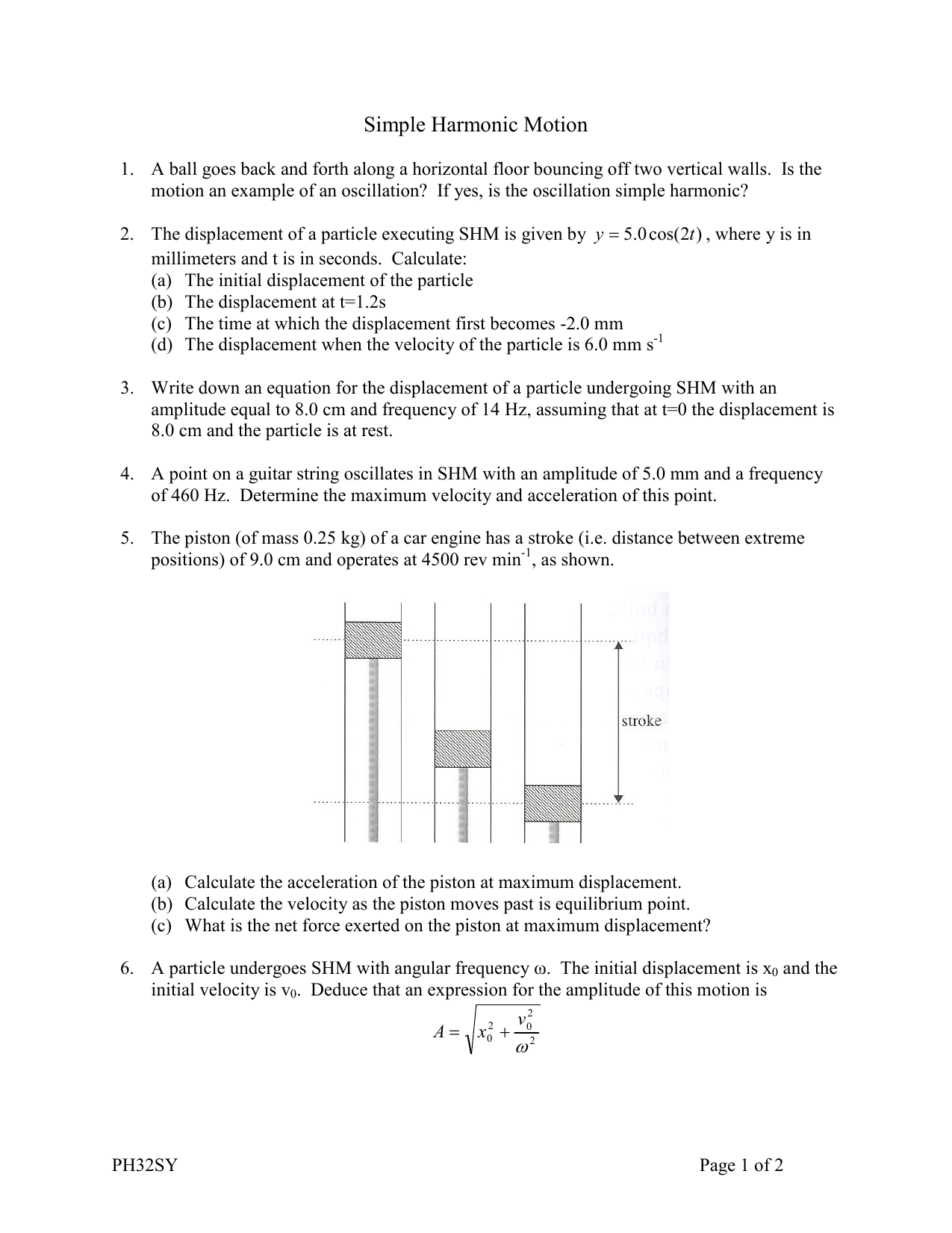

You may be wondering why we can’t do the same thing in order to find \(x(t)\) for the mass-spring system. Using Newton’s law for angular motion, I, I, d dt I 2 2 0. Computing the second-order derivative of in the equation gives the equation of motion.
SIMPLE HARMONIC MOTION HOW TO
In Chapter3, we found, \(x(t)\), from a function, \(a(t\)), by using simple integration. An Angular Simple Harmonic Oscillator When the suspension wire is twisted through an angle, the torsional pendulum produces a restoring torque given by. Copy to Clipboard Source Fullscreen It helps to understand how to get the differential equation for simple harmonic motion by linking the vertical position of the moving object to a point A on a circle of radius. We have found that our guess for \(x(t)\) satisfies the differential equation. We call \(\omega\) the “angular frequency” of the spring-mass system. Simple Harmonic Motion is a fundament concept in the study of motion, especially oscillatory motion which helps us understand many physical phenomena around like how strings produce pleasing sounds in a musical instrument such as the sitar, guitar, violin, etc. \] The last equation has exactly the same form as Equation 13.1.2, which we obtained from Newton’s Second Law, if we define \(\omega\) as: So we have approximate simple harmonic motion, where w 2 = g/l. If the particle is at P or Q when t = 0, then the following equation also holds:Ī simple pendulum consists of a particle P of mass m, suspended from a fixed point by a light inextensible string of length a, as shown here: If the particle is at 0 when t = 0, then the following equation also holds: Simple harmonic motion (SHM) is a special case of motion in a straight line which occurs in several examples in nature. The periodof the motion is the time it takes for the particle to perform one complete cycle. Simple harmonic motion is defined as a periodic motion of a point along a straight line, such that its acceleration is always towards a fixed point in that. If a body moves in such a way that its acceleration is directed towards a fixed point in its path and directly proportional to the distance from that point, the movement of the object is said to be simple harmonic. Case 2: The potential energy is maximum, and the kinetic energy is zero, at a maximum displacement point from the equilibrium point. Definition of Simple Harmonic Motion - SHM. Case 1: The potential energy is zero, and the kinetic energy is maximum at the equilibrium point where zero displacement takes place. Hence the maximum velocity is a w (put x = 0 in the above equation and take the square root). The system that performs simple harmonic motion is called the harmonic oscillator.

In the simple harmonic motion, the displacement of the object is always in the opposite direction of the restoring force. Where v is the velocity of the particle, a is the amplitude and x is the distance from O.įrom this equation, we can see that the velocity is maximised when x = 0, since v 2 = w 2a 2 - w 2x 2 Simple harmonic motion is the motion in which the object moves to and fro along a line. We can solve this differential equation to deduce that: If so, you simply must show that the particle satisfies the above equation. You may be asked to prove that a particle moves with simple harmonic motion. Simple harmonic motion definition, vibratory motion in a system in which the restoring force is proportional to the displacement from equilibrium.

Where w is a constant (note that this just says that the acceleration of the particle is proportional to the distance from O). The amplitudeof the motion is the distance from O to either P or Q (the distances are the same).Ī particle which moves under simple harmonic motion will have the equation The particle will therefore move between two fixed points (P and Q). It focuses on the mass spring system and shows you how to calculate variables su. Simple harmonic motion is typified by the motion of a mass on a spring when it is subject to the linear elastic restoring force given by Hookes Law. It will keep going and then again slow down as it reaches P before stopping at P and returning to O once more. This physics video tutorial explains the concept of simple harmonic motion. Simple Harmonic Motion arises when we consider the motion of a particle whose acceleration points towards a fixed point O and is proportional to the distance of the particle from O (so the acceleration increases as the distance from the fixed point increases).Īs the particle moves away from the fixed point O, since the acceleration is pointing towards O, the particle will slow down and eventually stop (at Q), before returning to O.


 0 kommentar(er)
0 kommentar(er)
